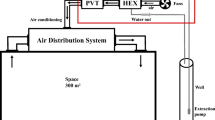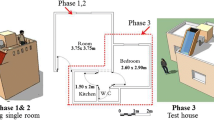Abstract
To achieve required indoor air quality, fresh air supply in buildings should meet relevant standards and regulations. However, the handling of fresh air introduced a cooling load that takes up a large portion of building energy consumption, especially in tropical and subtropical areas. A proper way should be employed to reduce the cooling load of fresh air. Radiative sky cooling, which is the process that an object cools itself by emitting thermal radiation to outer space without any energy input, is a cost-effective and eco-friendly technology. In this work, a fresh air pre-cooling system using radiative sky cooling is proposed to reduce fresh air cooling load. The system, consisting of filters, a radiative air-cooling system, an air handling unit (AHU), fans, etc., is installed on the rooftop of the modeled building. Six cities in low-latitude areas are selected and investigated. Results show that with the radiative air-cooling system installed, annual cooling energy consumption of the modeled building can be reduced by around 10% in most cities. For arid areas, e.g., Abu Dhabi, the system has even better performance with 19.34% annual cooling energy saving.
Similar content being viewed by others
Abbreviations
- A :
-
total radiative cooling surface area (m2)
- c :
-
speed of light (m/s)
- \({c_{{\rm{p}}\_{\rm{air}}}}\) :
-
specific heat capacity of the air (J/(kg·K))
- C air :
-
heat capacity rates of the air (W/K)
- C duct :
-
heat capacity rates of the duct (W/K)
- d e :
-
hydraulic diameter of the duct (m)
- f :
-
Darcy friction factor
- g :
-
gravitational acceleration constant (m/s2)
- h :
-
Planck constant (J·s)
- h inner :
-
heat transfer coefficient inside the duct (W/(m2·K))
- h upper :
-
heat transfer coefficient above the upper surface (W/(m2·K))
- I bb :
-
blackbody radiance (W/m2)
- I direct :
-
direct normal solar radiance (W/m2)
- I diffuse :
-
diffuse horizontal solar radiance (W/m2)
- I solar :
-
total solar irradiance (W/m2)
- k air :
-
thermal conductivity of air (W/(m·K))
- k B :
-
Boltzmann constant (J/K)
- L :
-
length of the duct (m)
- N :
-
cloud cover
- Nu :
-
Nusselt number
- Pr :
-
Prandtl number
- P atm :
-
absorbed atmospheric radiation (W)
- P net :
-
net cooling power (W)
- P non-rad :
-
heat loss due to conduction and convection (W)
- P rad :
-
energy emitted from the radiative cooling surface (W)
- P solar :
-
absorbed solar irradiance (W)
- PWV:
-
precipitable water vapor (cm)
- ΔP :
-
pressure drop along the duct (Pa)
- Q fresh :
-
fresh air cooling load of the modeled building (W)
- q v :
-
volume flow rate of the air (m3/s)
- Re :
-
Reynolds number
- RH:
-
relative humidity (%)
- S :
-
friction loss (m)
- T amb :
-
ambient temperature (K)
- T design :
-
indoor cooling setpoint temperature (K)
- T en :
-
temperature of the duct at the entrance (K)
- T outlet :
-
outlet temperature of the air (K)
- T s :
-
radiative cooling surface temperature (K)
- ΔT m :
-
logarithmic mean temperature difference (K)
- t d :
-
dew point temperature (°C)
- u :
-
velocity of the airflow (m/s)
- v :
-
wind speed (m/s)
- W fan :
-
fan power (W)
- α s :
-
solar absorptance of the radiative cooling surface
- ε atm :
-
emissivity of the atmosphere
- ε s :
-
emissivity of the radiative cooling surface
- η f :
-
fan efficiency
- λ :
-
wavelength (µm)
- ρ air :
-
density of the air (kg/m3)
References
Abimbola O, Falaiye O (2016). Estimation of precipitable water vapour in Nigeria using surface meteorological data. Ife Journal of Science, 18: 541–549.
Akpootu DO, Iliyasu MI, Mustapha W, et al. (2019). Models for estimating precipitable water vapour and variation of dew point temperature with other parameters at Owerri, South Eastern, Nigeria. Journal of Water Resources and Ocean Science, 8: 28.
ASHRAE (2017). ASHRAE Handbook—Fundamentals. Atlanta: American Society of Heating, Refrigerating and Air-Conditioning Engineers.
Baniassadi A, Sailor DJ, Ban-Weiss GA (2019). Potential energy and climate benefits of super-cool materials as a rooftop strategy. Urban Climate, 29: 100495.
CBECS (2012). A Look at the U.S. Commercial Building Stock: Results from EIA’s 2012 Commercial Buildings Energy Consumption Survey (CBECS). https://www.eia.gov/consumption/commercial/reports/2012/buildstock/.
Chen Y, Mandal J, Li W, et al. (2020). Colored and paintable bilayer coatings with high solar-infrared reflectance for efficient cooling. Science Advances, 6: eaaz5413.
Fang H, Zhao D, Yuan J, et al. (2019). Performance evaluation of a metamaterial-based new cool roof using improved Roof Thermal Transfer Value model. Applied Energy, 248: 589–599.
Fu SC, Zhong XL, Zhang Y, et al. (2020). Bio-inspired cooling technologies and the applications in buildings. Energy and Buildings, 225: 110313.
Hu M, Zhao B, Ao X, et al. (2018). Parametric analysis and annual performance evaluation of an air-based integrated solar heating and radiative cooling collector. Energy, 165: 811–824.
IEA (2020). Tracking Buildings 2020. International Energy Agency. Available at https://www.iea.org/reports/tracking-buildings-2020.
Jeong SY, Tso CY, Ha J, et al. (2020). Field investigation of a photonic multi-layered TO2 passive radiative cooler in sub-tropical climate. Renewable Energy, 146: 44–55.
Lawrie LK, Crawley DB (2020). Development of Global Typical Meteorological Years (TMYx). Available at http://climate.onebuilding.org/.
Li T, Zhai Y, He S, et al. (2019). A radiative cooling structural material. Science, 364: 760–763.
Liu J, Li W, Liu J, et al. (2010). Efficiency of energy recovery ventilator with various weathers and its energy saving performance in a residential apartment. Energy and Buildings, 42: 43–49.
Liu J, Zhou Z, Zhang D, et al. (2020). Field investigation and performance evaluation of sub-ambient radiative cooling in low latitude seaside. Renewable Energy, 155: 90–99.
Liu J, Zhang J, Tang H, et al. (2021). Recent advances in the development of radiative sky cooling inspired from solar thermal harvesting. Nano Energy, 81: 105611.
Lyu W, Li X, Wang B, et al. (2019). Energy saving potential of fresh air pre-handling system using shallow geothermal energy. Energy and Buildings, 185: 39–48.
Mandal J, Fu Y, Overvig AC, et al. (2018). Hierarchically porous polymer coatings for highly efficient passive daytime radiative cooling. Science, 362: 315–319.
Mandal J, Yang Y, Yu N, Raman AP (2020). Paints as a scalable and effective radiative cooling technology for buildings. Joule, 4: 1350–1356.
Ningombam SS, Jade S, Shrungeshwara TS (2018). Parameterization of water vapor using high-resolution GPS data and empirical models. Journal of Atmospheric and Solar-Terrestrial Physics, 168: 58–69.
Niu J (2001). Membrane-based Enthalpy Exchanger: material considerations and clarification of moisture resistance. Journal of Membrane Science, 189: 179–191.
Office of Energy Efficiency & Renewable Energy (2012). Existing Commercial Reference Buildings Constructed In or After 1980. Available at https://www.energy.gov/eere/buildings/existing-commercial-reference-buildings-constructed-or-after-1980.
Raman AP, Anoma MA, Zhu L, et al. (2014). Passive radiative cooling below ambient air temperature under direct sunlight. Nature, 515: 540–544.
Reitan CH (1963). Surface dew point and water vapor aloft. Journal of Applied Meteorology, 2: 776–779.
Smith WL (1966). Note on the relationship between total precipitable water and surface dew point. Journal of Applied Meteorology, 5: 726–727.
Wang L, Liu X, Brown H (2017). Prediction of the impacts of climate change on energy consumption for a medium-size office building with two climate models. Energy and Buildings, 157: 218–226.
Yin X, Yang R, Tan G, et al. (2020). Terrestrial radiative cooling: Using the cold universe as a renewable and sustainable energy source. Science, 370: 786–791.
Zhai Y, Ma Y, David SN, et al. (2017). Scalable-manufactured randomized glass-polymer hybrid metamaterial for daytime radiative cooling. Science, 355: 1062–1066.
Zhao J, Lasternas B, Lam KP, et al. (2014). Occupant behavior and schedule modeling for building energy simulation through office appliance power consumption data mining. Energy and Buildings, 82: 341–355.
Zhao D, Aili A, Yin X, et al. (2019a). Roof-integrated radiative air-cooling system to achieve cooler attic for building energy saving. Energy and Buildings, 203: 109453.
Zhao D, Aili A, Zhai Y, et al. (2019b). Radiative sky cooling: Fundamental principles, materials, and applications. Applied Physics Reviews, 6: 021306.
Zhao D, Aili A, Zhai Y, et al. (2019c). Subambient cooling of water: toward real-world applications of daytime radiative cooling. Joule, 3: 111–123.
Zhou L, Song H, Liang J, et al. (2019). A polydimethylsiloxane-coated metal structure for all-day radiative cooling. Nature Sustainability, 2: 718–724.
Zhou K, Miljkovic N, Cai L (2021). Performance analysis on system-level integration and operation of daytime radiative cooling technology for air-conditioning in buildings. Energy and Buildings, 235: 110749
Acknowledgements
Dongliang Zhao acknowledges the support from the Natural Science Foundation of Jiangsu Province, China (Grant No. BK20200373).
Author information
Authors and Affiliations
Corresponding author
Rights and permissions
About this article
Cite this article
Xu, D., Boncoeur, S., Tan, G. et al. Energy saving potential of a fresh air pre-cooling system using radiative sky cooling. Build. Simul. 15, 167–178 (2022). https://doi.org/10.1007/s12273-021-0802-y
Received:
Revised:
Accepted:
Published:
Issue Date:
DOI: https://doi.org/10.1007/s12273-021-0802-y




